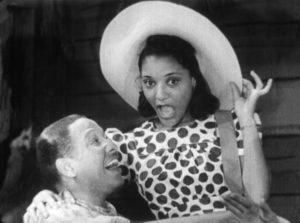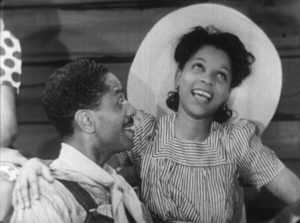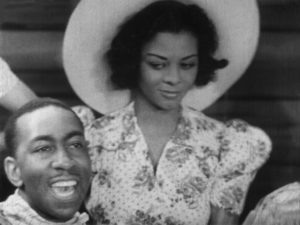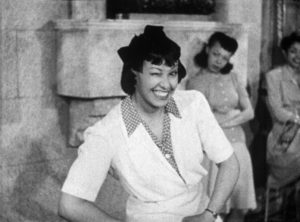An Online Movie Jukebox




It’s almost impossible to read about these films without wanting to see at least a few of them.
And with good reason.
These Soundies are an overlooked chapter in Black entertainment history in the 1940s. They have a different story to tell about American life in the wartime era—and about race relations in that turbulent time, told through the pop culture of the day.
To make it easier to watch as you read, this site has all of the Soundies available online that I discuss in the text.
Presented chapter by chapter, they’re a movie jukebox for the book.
The videos are embedded from YouTube. You can watch them there too, but if the idea is to keep reading, it’s probably best to watch here—fewer distractions, fewer rabbit holes.
Whether you watch here or on YouTube, here’s to the pleasure of discovering these films and their performers (with apologies for the ads that pop up). And exploring the little-known histories in Soundies and the Changing Image of Black Americans on Screen: One Dime at a Time.

Here’s a sneak preview, chapter by chapter.
Jump to Soundies in Chapter
[Intro] [1] [2] [3] [4] [5.1] [5.2] [6] [7.1] [7.2] [8] [9.1] [9.2] [10] [11]
Part One. Follow the Money
Introduction: “Turning on a Dime”
Take the ‘A’ Train (1941)
A Black metropolis envisioned by way of the Duke Ellington-Billy Strayhorn song, performed by the Delta Rhythm Boys.
Chapter 1: “Circa 1940—Race and the Pop-Culture Landscape”
Sugar Hill Masquerade (1942)
Dancer Alice Barker performed in several Soundies, including “Sugar Hill Masquerade.” I had the pleasure of meeting her when she was 102, and I write about her in the book.
Chapter 2: “Risky Business”
Quarry Road (1943)
A year before the Andrews Sisters’ version of “Rum and Coca Cola” brought calypso into the spotlight in the US, Trinidad-born Sam Manning and Belle Rosette (Beryl McBurnie) made two Soundies. Image and sound aren’t always in sync here—something that happens fairly frequently in Soundies.
Chapter 3: “Starting in Hollywood, Heading to Harlem”
Jam Session (1942)
The most popular Soundie online, racking up more than 2 million views in multiple YouTube uploads. Duke Ellington and His Orchestra star, with several short solos.
Part Two. Follow the Music
Chapter 4: “Going to War”
Keep Smiling (1943)
An odd delivery from a terrific vocal group. The lyrics say “Keep Smiling,” but the Four Ginger Snaps start off with serious, almost wooden expressions . The setting for this War Bonds pitch is a movie theater, where the bonds were frequently sold, often with free admission for the purchasers.
Chapter 5: “Encounter and Improvisation—Reimagining the City”
Give Me Some Skin (1946)
Another Soundie with the Delta Rhythm Boys. The producer and director are not known, but few Soundies are as experimental in their visual approach.
Chapter 6: “Rural Reverb”
Sleep Kentucky Babe (1945)
Day, Dawn, and Dusk dismantle an 1896 “plantation lullaby” with a culinary salute to 1940s urban diversity. Poor video quality and breaks in the film, but nothing diminishes the trio’s performance.
Chapter 7: “Romance, Relationships, Legs”
Hark! Hark! The Lark (1941)
A 3-minute rom-com, courtesy of the Deep River Boys and four women bit players. In the book, I write a lot about the uncredited women actors who give the films such style and verve.
Chapter 8: “One Performer, Ten Soundies—Another Look at Dorothy Dandridge”
Cow-Cow Boogie (1942)
The most popular of Dandridge’s Soundies on YouTube. She was 19 when she made it, and she just about burns through the screen.
Chapter 9: “Visual Music—Big Bands, Combos, Solo Musicians”
Air Mail Special (1941)
Dynamic editing of the band shots makes Count Basie and His Orchestra more than a match for the dancers (Whitey’s Lindy Hoppers, in one of their more subdued performances). Basie band member Jimmy Rushing provides the comic punchline as a winner in the dance marathon. With an animated intro by the YouTube uploader.
Chapter 10: “Backing into Integration”
Let Me Off Uptown (1942)
In the early 1940s, drummer Gene Krupa’s big band was one of the few white bands with a Black member: star trumpeter Roy Eldridge. Eldridge’s bantering on-camera exchange with singer Anita O’Day was an interracial rarity, unlikely to turn up anywhere but in Soundies.
Chapter 11: “Unplugged, with an Afterlife”
She’s Too Hot to Handle (1944)
With his easygoing ad lib style, Bob Howard was one of the first Soundies stars to transition to television, hosting his own show in 1948.
Jump to Soundies in Chapter
[Intro] [1] [2] [3] [4] [5.1] [5.2] [6] [7.1] [7.2] [8] [9.1] [9.2] [10] [11]